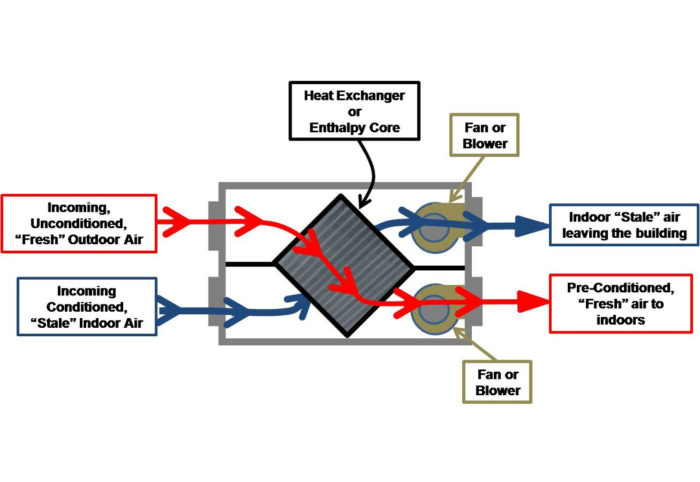Checking out the Perks of Heat Recovery Ventilation for Energy Performance in Houses
Heat Recovery Ventilation (HRV) systems use property owners a sensible strategy to enhancing energy efficiency. By redeeming heat from outgoing air, these systems can significantly minimize cooling and heating costs. Additionally, they offer a stable supply of fresh air, improving interior air high quality and comfort degrees. As property owners think about lasting alternatives, recognizing the subtleties of HRV systems comes to be increasingly vital. What variables should one examine prior to making such an investment?
Comprehending Heat Recovery Ventilation Systems

Just How HRV Boosts Indoor Air Quality

Energy Financial Savings: The Economic Advantages of HRV
Making the most of energy efficiency, heat recovery ventilation (HRV) systems provide significant monetary benefits for house owners. By recouping and reusing warm from exhaust air, HRVs noticeably minimize cooling and heating expenses. This innovation can bring about energy financial savings of approximately 30%, depending on environment and usage patterns. Homeowners often discover minimized utility expenses quickly after setup, making HRVs an economically smart investment in time. Furthermore, several areas provide motivations or refunds for energy-efficient upgrades, better improving the economic charm. As power costs continue to climb, the cost-effectiveness of HRVs becomes progressively clear. Overall, the incorporation of HRV systems not only promotes energy effectiveness however additionally adds to long-term financial cost savings for houses.
The Environmental Effect of Heat Recovery Ventilation
A substantial ecological benefit of heat recovery ventilation (HRV) systems hinges on their capacity to decrease general energy intake. By reclaiming heat from exhaust air and moving it to incoming fresh air, HRV systems reduce the requirement for energy-intensive heating and cooling approaches. This decrease in energy demand adds to decrease greenhouse gas exhausts, as less fossil gas is called for to keep comfortable indoor temperatures. official website Furthermore, HRV systems improve interior air quality by effectively exchanging stale air with fresh exterior air, reducing reliance on mechanical cooling systems that can damage the atmosphere. Overall, the implementation of HRV systems sustains sustainable living techniques and straightens with international efforts to combat environment adjustment by promoting power performance in domestic settings.
Selecting the Right HRV System for Your Home
Just how can house owners assure they pick the right heat recovery ventilation (HRV) system for their needs? Initially, they ought to examine their home's size and layout, as these variables influence air flow demands. Next, assessing the system's efficiency ratings is crucial, as greater rankings indicate much better efficiency and power savings. House owners must likewise consider installment and maintenance expenses, contrasting different brand names and designs for worth. Additionally, it's crucial to evaluate noise degrees, as some systems operate even more silently than others. Consulting with heating and cooling specialists can offer customized referrals based on certain home problems. Taking a look at individual reviews and service warranties can assist in making an educated decision, making certain that the chosen HRV system properly enhances interior air high quality and power effectiveness.
Often Asked Concerns

Just how Usually Should I Clean or Preserve My HRV System?
The regularity of cleansing or preserving a warmth healing air flow (HRV) system usually relies on usage and ecological variables. Typically, it is a good idea to execute maintenance every 6 months to assure peak performance and air top quality.

Can HRV Equipments Help In Reducing Moisture Levels Inside?
HRV systems can effectively decrease interior moisture degrees by exchanging stale, damp air with fresh, drier air from outside. HRV Heat Recovery Ventilation. This procedure assists maintain a well balanced indoor atmosphere, improving convenience and protecting against moisture-related problems
What Is the Lifespan of a Normal HRV System?
The life expectancy of a common heat recovery ventilation (HRV) system varies, usually lasting in between 10 to 15 years. Regular maintenance can expand its redirected here effectiveness and functional life, making certain peak performance throughout its use period.
Are There Any Kind Of Sound Interest In HRV Systems?
Noise interest in HRV systems can develop, specifically from fan procedure. Nevertheless, lots of modern-day units are created to lessen audio levels, guaranteeing they run quietly while maintaining effectiveness, which attends to possible disturbances in living settings.
Can I Mount an HRV System Myself, or Do I Need an Expert?
The specific contemplated whether to mount the heat recovery ventilation (HRV) system directly or employ a professional. Generally, while DIY installation is possible, proficiency warranties proper capability and compliance with neighborhood building regulations, boosting system effectiveness.